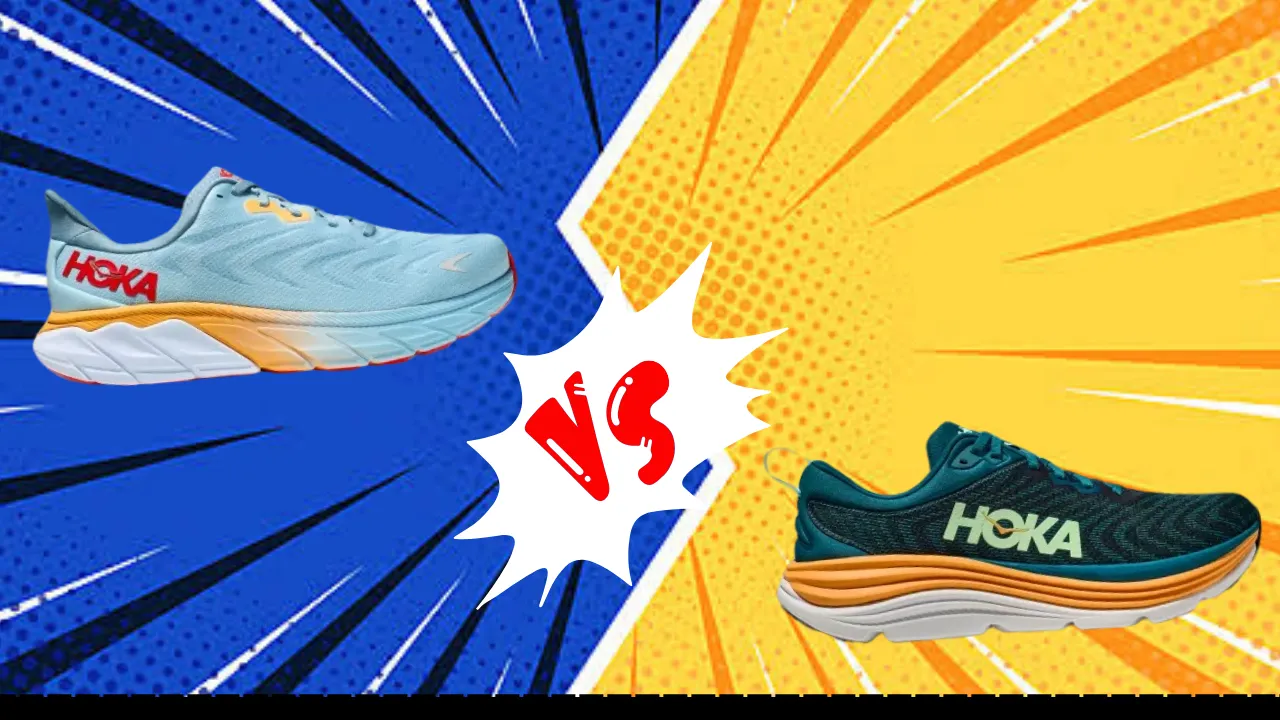If you’re a runner searching for your next pair of stability shoes, you may be trying to decide between the Hoka Arahi 6 and the Hoka Gaviota 5. Both shoes are made by Hoka One One and provide stability and support for overpronators, but they have some key differences that may make one a better choice for your needs.
Read on for a detailed comparison of the Arahi 6 and Gaviota 5’s features, performance, and overall value to help you determine which Hoka stability shoe is the best pick for you.
Similarities And Differences Between Arahi 6 And Gaviota 4:
| Feature | Hoka Arahi 6 | Hoka Gaviota 5 |
|---|---|---|
| Launched In | 2022 | 2023 |
| Stability | Moderate | Maximum |
| Flexibility | Good | Limited |
| Sizing | Men’s 7-13, Women’s 5-11 | Men’s 7-13, Women’s 5-11 |
| Weight | 9.3 oz (M), 8.7 oz (W) | 10.9 oz (M), 9.9 oz (W) |
| Cushion | CMEVA foam | CMEVA foam |
| Outsole | Durable rubber | Durable rubber |
| Midsole | CMEVA foam | CMEVA foam |
| Upper | Lightweight, breathable mesh | Lightweight, breathable mesh |
| Retail Price | $140 | $175 |
Features Comparison
Materials
The Arahi 6 and Gaviota 5 both utilize CMEVA foam in the midsole, which provides responsive cushioning and stability. The outsoles on both shoes incorporate durable rubber for traction and abrasion resistance. Both models also have lightweight, breathable mesh uppers.


However, the Gaviota 5 uses a thicker midsole stack height for enhanced cushioning, making it slightly heavier than the Arahi 6. The Arahi 6 focuses more on delivering a firmer, more responsive ride.
Durability
With their durable rubber outsoles and sturdy CMEVA foam midsoles, both the Arahi 6 and Gaviota 5 are built to last through many miles of training and racing. The Arahi 6 tends to hold up especially well even under heavy use thanks to the denser foam and protective outsole.
Some runners have gotten over 500 miles out of the Arahi 6 before needing to replace them, while the Gaviota 5 averages around 300-400 miles of use before signs of wear. So the Arahi 6 seems to have a slight edge in longevity.
Fit
The Arahi 6 runs true to size for most runners, with a medium width through the midfoot and toe box. The Gaviota 5 has a wider base and toe box to accommodate runners who need more stability, so some may want to size down half a size in the Gaviota 5 if they have narrower feet.


Both shoes use a padded tongue and collar for comfort. The Gaviota 5’s maximum stability makes it slightly stiffer, while the Arahi 6 has a more pliable upper for a snugger fit. Those needing more room for swelling or orthotics may prefer the Gaviota 5.
Stability
As a moderate stability shoe, the Arahi 6 provides a good amount of support and guidance for mild to moderate overpronators without being too rigid or controlling. The Gaviota 5 is made for severe overpronators who need maximum motion control, courtesy of its sturdy frame and medial support.
Runners needing mild stability can get by with the Arahi 6, while those with flat feet or who are heavy overpronators will likely appreciate the Gaviota 5’s superior control. The Gaviota 5 also helps control supination.
Cushioning
The Arahi 6 offers firm yet responsive cushioning that remains consistent even over long distances. The Gaviota 5 provides plush, soft cushioning to absorb impact but isn’t quite as responsive.
Runners needing more softness underfoot for shock absorption may favor the Gaviota 5’s plusher ride, while those wanting a responsive, mildly cushioned feel will appreciate the Arahi 6. The Gaviota 5 also has a few millimeters of additional stack height for enhanced cushioning.
Value for Money
At $140, the Arahi 6 is $35 less expensive than the $175 Gaviota 5. For runners on a budget or wanting great stability without the maximum features of the Gaviota 5, the Arahi 6 delivers excellent value at its reasonable price point.
However, the Gaviota 5 is a worthwhile investment for overpronators who depend on maximum stability and cushioning. For these runners, the Gaviota 5’s superior motion control and comfort over long distances justify the slightly higher cost.
Performance Comparison
For Walking
The Arahi 6 and Gaviota 5 both perform well for walking and casual use, thanks to their cushioned midsoles and supportive frames. The Arahi 6 offers a responsive feel that makes it a good choice for comfortable walking at an energetic pace.
Meanwhile, the Gaviota 5’s plush cushioning absorbs shock better, making it ideal for extended walking sessions or recovery days when you want a softer feel underfoot. The Gaviota 5 also provides the most stability, catering to overpronators.
For Running
During runs, the Arahi 6 provides a firm yet smooth ride. Its energetic cushioning and moderate stability make it suitable for tempo runs and daily training for mild to moderate overpronators.
The Gaviota 5 is the better choice for logging long, slow mileage. Its soft cushioning keeps legs fresh even after many miles, while its maximum stability controls overpronation on longer runs. Severe overpronators will benefit most from the Gaviota 5.
For Plantar Fasciitis
The ample cushioning in both models helps absorb shock to reduce pain and inflammation from plantar fasciitis. However, the Gaviota 5 is particularly effective for this condition thanks to its plush cushioning and medial support. It helps control overpronation that can aggravate plantar fasciitis while softening every foot strike.
For Standing All Day
For people whose jobs require standing for prolonged periods, the cushioned midsoles in the Arahi 6 and Gaviota 5 provide comfort and fatigue relief.
The Gaviota 5 offers slightly better shock absorption for all-day wear, making it the top choice for occupations that involve a lot of standing. Both are much kinder to feet than regular shoes.
Final Verdict
For mild overpronators seeking a responsive yet supportive stability shoe for faster training and races, the Hoka Arahi 6 is an excellent choice that also saves you some money.
If you need maximum stability and plush cushioning in a workhorse shoe for daily mileage, recovery runs, and long distances, then the Hoka Gaviota 5 is a smart investment, especially if you struggle with severe overpronation or plantar fasciitis.
Let your specific needs and preference for responsiveness vs. soft cushioning guide you toward the stability shoe that’s right for you. Both the Arahi 6 and Gaviota 5 are top-notch options within the category.

